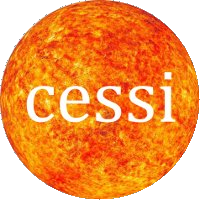SPACE WEATHER ASSESSMENT AND PREDICTIONS
Center of Excellence in Space Sciences India, IISER Kolkata

ACKNOWLEDGEMENTS
Solar Dynamics Observatory (SDO) is the first mission to be launched for NASA's Living With a Star (LWS) Program. The data from the SDO/HMI and SDO/AIA consortia are provided by the Joint Science Operations Center (JSOC) Science Data Processing at Stanford University.
The Global Oscillation Network Group (GONG) Program, is managed by the National Solar Observatory, which is operated by AURA, Inc. under a cooperative agreement with the National Science Foundation. GONG data are acquired by instruments operated by the Udaipur Solar Observatory (Physical Research Laboratory), Big Bear Solar Observatory, High Altitude Observatory, Learmonth Solar Observatory, Instituto de Astrofisica de Canarias, and Cerro Tololo Interamerican Observatory.
The Solar and Heliospheric Observatory (SOHO) is a mission of international cooperation between ESA and NASA. The SOHO/LASCO CME catalog is generated and maintained at the CDAW Data Center by NASA and The Catholic University of America in cooperation with the Naval Research Laboratory.
The PRoject for Onboard Autonomy (PROBA) is an ESA microsatelite. It is a part of ESA's in-orbit Technology Demonstration program. The Sun Watcher using Active Pixel System detector and Image Processing (SWAP) telescope on board PROBA2 provides images of the solar corona at about 174 Å.
The Geostationary Operational Environmental Satellites (GOES) is operated by the National Oceanic and Atmospheric Administration’s (NOAA’s) National Environmental Satellite, Data, and Information Service division. The X-ray Sensor (XRS) of GOES provides solar X-ray fluxes for the wavelength bands of 0.5 to 4 Å and 1 to 8 Å. The Solar UltraViolet Imager (SUVI) on board GOES monitors the Sun in the extreme ultraviolet range.
The Advanced Composition Explorer (ACE) is an explorer mission managed by NASA’s Office of Space Science Mission and Payload Development Division. The Solar wind electron, Proton and Alpha Monitor (SWEPAM) and Magnetic Field Experiment (MAG) instruments on board ACE measures the in situ solar wind plasma parameters and magnetic properties at 1 astronomical unit (au). The most recent ACE Real-Time Solar Wind (RTSW) Data is provided by NOAA's Space Weather Prediction Center.
The solar active region summary and daily geomagnetic indices are prepared by the NOAA, Space Weather Prediction Center and the U.S. Air Force.
The Center of Excellence in Space Sciences India is funded under the Frontier Areas of Science and Technology (FAST) scheme of the Ministry of Human Resource Development (MHRD), Government of India.
The following students and scientists of CESSI have contributed to the development of our space weather assessment, modelling and predictions capability over the years. Sanchita Pal, Suvadip Sinha, Soumyaranjan Dash, Om Gupta, Yoshita Baruah, Prantika Bhowmik, Srijan Das, Rajashik Tarafder, Aditi Bhatnagar, Suman Panda, Arnab Basak. Prosenjit Lahiri has assisted in the development and maintenance of this website. The research to operational space weather forecasting effort at CESSI, IISER Kolkata is led by Dibyendu Nandi.